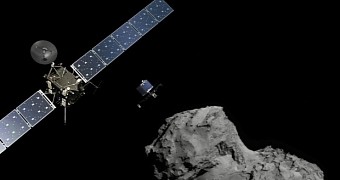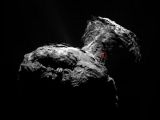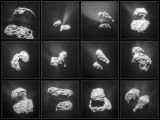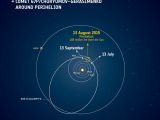This coming Thursday, August 13, the Rosetta probe, Comet 67P/Churyumov-Gerasimenko, which the spacecraft has been orbiting for about a year now, and the Philae lander, which has been straddling the orb since last November, will all buzz by the Sun.
Well, the comet will be the one that will fly by the star on its own accord.
As for the Rosetta spacecraft and the Philae lander, they will merely follow its lead. Rosetta because it is gravitationally bound to it and following the orb on its journey is its mission, Philae because it's stuck on the surface of 67P/Churyumov-Gerasimeno.
So, how close to the Sun will they get?
When making its closest approach to the Sun this Thursday, Comet 67P/Churyumov-Gerasimenko will come within about 186 million kilometers (115 million miles) of the star.
This point in its orbit when it is closest to the Sun is known as perihelion. Scientists estimate that, this time around, 67P/Churyumov-Gerasimenko's perihelion will occur at 02:03 GMT.
The comet, which takes around 6.5 years to complete its elliptical orbit, last came this close to the Sun on February 28, 2009, when it flew between the orbits of Earth and Mars.
When at its most distant, i.e. at aphelion, 67P/Churyumov-Gerasimenko stands an estimate 850 million kilometers (528 million miles) away, just beyond the orbit of Jupiter.
Worry not, the comet will not be destroyed
True, it often happens that comets that get too close to the Sun are pretty much obliterated by the heat and the solar energy coming their way. Still, this will not happen to 67P/Churyumov-Gerasimenko.
All the same, the comet will undoubtedly be shaken up by the encounter. Astronomers expect that, both at perihelion and in the weeks after its flyby of the Sun, frozen ice on the comet's surface will sublimate and outbursts will happen.
In fact, it looks like the comet is already responding to more solar energy reaching its surface. Thus, a couple of weeks back, Rosetta witnessed a rather dramatic outburst on one of the comet's lobes.
Although unlikely, its close approach to the Sun might widen a 500-meter-long (1,640 feet) fracture running along the comet's neck. Still, astronomers seriously doubt the orb will break apart.
Following perihelion, the Comet 67P/Churyumov-Gerasimeno will remain a tad hyperactive for a few weeks. Still, once it begins to cool, it will return to its usual calm self.
“Thanks to the heat absorbed during perihelion, the activity is expected to remain high for a couple of months before gently decreasing towards the moderate activity levels seen earlier in the mission,” explain scientists with the European Space Agency.
It'll be business as usual for Rosetta and Philae
Rather than execute complicated maneuvers to mark the event, the Rosetta spacecraft and the Philae lander will simply stick to business as usual.
Granted, Rosetta will approach Comet 67P/Churyumov-Gerasimenko so as to better image activity on its surface as the orb makes its way past the Sun, but Philae will not receive any special instructions.
“Perihelion is simply a moment in time, and in terms of operations, it is business as usual - no special maneuvers are required,” mission scientists explain.
Having accompanied Comet 67P/Churyumov-Gerasimenko on its journey past the Sun, the Rosetta spacecraft will continue to closely monitor it until next year's September, when it'll probably be lights out for its mission.

 14 DAY TRIAL //
14 DAY TRIAL // 



